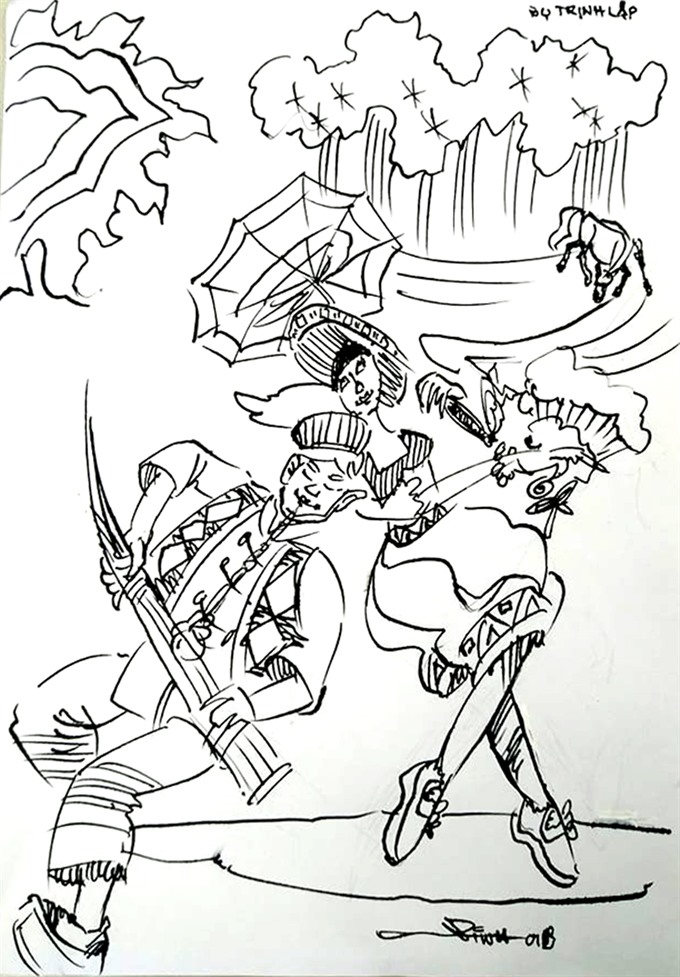 Talk Around Town
Talk Around Town

The Crystal Cloud, a public art installation on Mù Cang Chải rice terraced field in the northern province of Yên Bái recently drew criticism from locals and tourists.
 |
| Illustration by Trịnh Lập |
By Minh Thu
The Crystal Cloud, a public art installation on the Mù Cang Chải terraced rice field in the northern province of Yên Bái recently drew attention from locals and tourists.
It took two years to prepare for the project, two months to install it, but it remained on display for just two weeks. The artwork was removed early because it stirred controversy among the community.
Many people questioned if it’s suitable to put the dazzling artwork on a field where farmers and buffaloes work everyday, and if it’s necessary to beautify the rice fields, which are already charming and among the country’s national heritage.
Mù Cang Chải District has 500 hectares of terraced rice fields in La Pán Tẩn, Chế Cu Nha and Dế Xu Phình communes, cultivated by the ethnic Mông people for centuries. The local field where the artwork was installed is among 2,500 hectares recognised as national heritage sites in 2007 by the Ministry of Culture, Sports and Tourism.
The installation is a structure that features a cloud-like galvanized wire mesh decorated with 59,000 crystal beads attached to several poles on the top of Mâm Xôi Hill, one of Mù Cang Chải’s most popular tourist spots.
The art installation is the brainchild of landscape artists Andy Cao and Xavier Parrot. The execution of the project is a joint effort between the artists, local architects, the Mông community and Yên Bái provincial authorities.
Representing the organiser, architect Lê Việt Hà said the project received permission and the support of local residents and authorities. The organisers are committed to not harming the rice field and keeping the landscape completely intact after the exhibition. Proceeds from ticket sales will go to owners of the fields and volunteers.
The Crystal Cloud attracted thousands of locals and tourists alike on its opening days.
Many praised the exhibition for being creative and beautiful. "Whenever the sun shines, the light reflects and disperses into seven colours of the rainbow and can be seen from hundreds of metres away, even when you’re standing on nearby hills," said Nguyễn Thị Hương Liên, a visitor to the installation.
Others, however, weren’t so pleased. Many took to social media to express their disappointment, claiming that the Crystal Cloud is ugly and the installation is destroying the natural beauty of the landscape.
Photographer Đoàn Dũng, who has taken many photos of the rice fields in Mù Cang Chải, said he felt disappointed.
"I don’t know what is beautiful about it, the original nature is already a masterpiece. It’s just going to ruin it," he said.
“Terraced fields in Mù Cang Chải are beautiful all year round. Visitors in March can see glittering water surface before locals transplant rice seedlings from April to May. After May, the hills are covered in green until the fields start to turn yellow with ripe rice in early September. During the harvest in October, the golden rice fields stand out amidst green forests.”
“Instead of the terraced fields, now I see soulless iron poles and a grey cloud,” said Dũng.
“People praise the natural beauty of the fields with farmers and buffaloes working on the crop, that’s enough for the site. The fields have attracted many people and stood as inspiration for many artists. We don’t need any artificial works.”
Photographer Maika Elan said personally, she thinks the artwork is beautiful. She suggested that people should be open-minded.
“We should encourage pioneers in art,” she said. “If you love the site, you would accept its new face, instead of the stereotype, the same things year on year.”
Public art
Many art experts agreed that the installation of Crystal Cloud inspired a discussion on public art.
"Public art is art in any media like sculpture, performing art, and graffiti that has been planned and executed with the intention of being staged in the physical public domain, usually outside and accessible to all," said art expert Đào Mai Trang.
“Public art can express community values, enhance our environment, and transform a landscape. Placed in public sites, this art is there for everyone, a form of collective community expression. Public art is a reflection of how we see the world – the artist’s response to our time and place combined with our own sense of who we are,” she said.
“Public art is a part of our public history, part of our evolving culture and our collective memory. It reflects and reveals our society and adds meaning to our cities.”
Trang pointed out that there is a lack of space to display the plentiful artworks created by artists every year. Public spaces also become degraded without continual upkeep and attention.
“There are good artworks created by famous artists,” Trang said. “But they attract public attention for just a short time after the grand opening. They are soon forgotten and no one takes care of them.
Artist Vũ Hồng Nguyên, initiator of the project Art in the Forest launched at Flamingo Đại Lải Resort in the northern province of Vĩnh Phúc, said artists have many works to display for the public and the people also have a demand to enjoy public art, however, there is no particular plan for displaying them.
“It’s necessary to consider public art in urban planning,” he said. VNS




